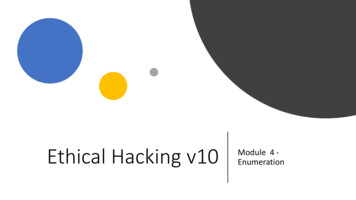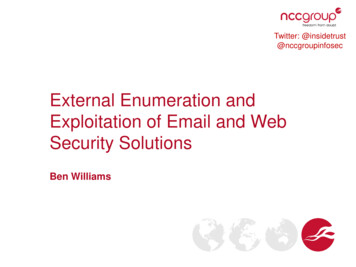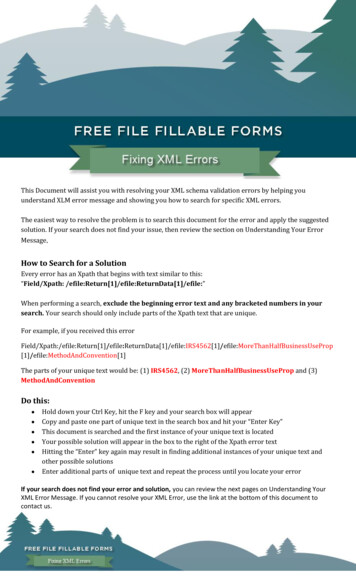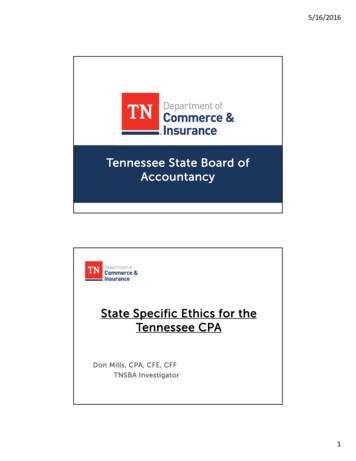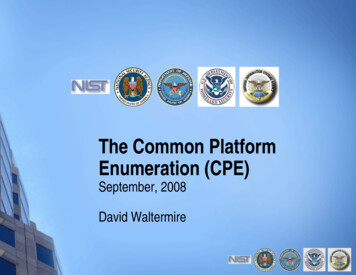
Transcription
The Common PlatformEnumeration (CPE)September, 2008David Waltermire
Discussion Points Technical Use Cases CPE Overview Enterprise Use Cases Current Issues
Technical Use Cases Identification Matching and Querying Product inventory
CPE provides a standardized naming scheme forproducts allowing identification All applications share a common product vocabularyallowing interoperability Allows identification of products at a standardized level ofgranularity Data can be associated with products by referencing aCPE Name
CPE provides powerful querying capabilities Allows searching of products based on abstract CPEName based search criteria The CPE Language provides matching capabilities usinglogical groupings of products
CPE provides automation capabilities for assetinventory Use of inventory definitions provides a technicalmechanism for determining the presence of products onan asset Mappings to/from CPE names allows integration intolegacy architectures that do not speak CPE
CPE Overview CPE Name Format CPE Name matching and the CPE Language CPE Dictionary
A CPE name is a special type of URIThe URI scheme Identifies that the URI is a CPE name The “cpe” scheme has not been registered with IANAThe scheme specificpart Uses special syntax specific to CPE A URI may contain only ASCIIcharacters Hierarchical by nature Each component is separated by acoloncpe:/ {part} : {vendor} : {product} : {version} : {update} : {edition} : {language}
The part component classifies the CPE namePossible values are:h – Hardwareo – Operating Systema – Applicationcpe:/ {part} : {vendor} : {product} : {version} : {update} : {edition} : {language}
The vendor component is the supplier of the product Each vendor organization has a unique name Generally represents the highest organization-specific label of theorganization’s DNS name Products developed by individuals outside of an organization canuse the creator’s nameOrganization’s Full NameDNS DomainVendor ComponentThe National Institute forStandards and Technologynist.govnistAcme Corporationacme.comacmeThe Acme Organizationacme.orgacme.orgJohn Doejohn doecpe:/ {part} : {vendor} : {product} : {version} : {update} : {edition} : {language}
The product component is the name of the product Generally represents the most common and recognizable name forthe product Multi-word names should be spelled out in full, replacing spaceswith underscores “ ”For example: application server linux kernel windows xpcpe:/ {part} : {vendor} : {product} : {version} : {update} : {edition} : {language}
The version component is the version of the product Should be the same format as what is seen within the product andon the systemFor example: 5.1 2.1.4.254cpe:/ {part} : {vendor} : {product} : {version} : {update} : {edition} : {language}
The update component represents a sub-release of a specificproduct version Used to represent beta, release candidates and service packs The “ga”, for general availability, placeholder may be used torepresent an initial release without an update specifiedFor example: gabeta2rc1sp3cpe:/ {part} : {vendor} : {product} : {version} : {update} : {edition} : {language}
The edition component represents a specific flavor of aproduct Often used to represent the target OS/software, architecture,and/or feature set of a productFor example: x86x64linux i386professionalcpe:/ {part} : {vendor} : {product} : {version} : {update} : {edition} : {language}
The language component indicates a language specificrelease of a product Any valid language tag defined by the IETF RFC 4646 Generally only language and region codes are necessaryFor example: en US – US Englishen GB – UK Englishes – Spanishja – Japanesezh - Chinesecpe:/ {part} : {vendor} : {product} : {version} : {update} : {edition} : {language}
Matching is used to determine if two CPE names refer to thesame set of products Applies a recursive algorithm that evaluates the CPE nameshierarchical structure Blank components match any valueFor example:cpe:/o::linux kernel:2.6.27::i586Would match:cpe:/o:kernel.org:linux kernel:2.6.27:rc6:i586cpe:/o:fedora:linux kernel:2.6.27:rc1:i586cpe:/o:redhat:linux kernel:2.6.27:ga:i586
The CPE Language allows arbitrary logical groupings of CPEnames to be evaluated using the matching algorithm Defines a collection of products Uses CPE name matching for evaluationFor example: cpe:platform id “abc123” cpe:title Microsoft Windows XP SP3 x64 Edition, US English releaseAND Microsoft Internet Explorer 7.0 Beta 3 /cpe:title cpe:logical-test operator “AND” negate “FALSE” cpe:fact-ref name “cpe:/o:microsoft:windows xp::sp3” / cpe:fact-ref name “cpe:/a:microsoft:ie:7.0 /cpe:logical-test /cpe:platform Would match the set of products:cpe:/o:microsoft:windows xp::sp3:x64:en UScpe:/a:microsoft:ie:7.0:beta3
The CPE Dictionary is an enumeration of CPENames Currently contains 15,000 CPE names Represents 3000 products from 200 vendors
The CPE Dictionary is a large XML catalogCPE Name cpe-item name "cpe:/a:microsoft:.net framework:2.0" title xml:lang "en-US" Microsoft .NET Framework 2.0 /title Internationalized checkTitlesystem 5"href inition." oval:org.mitre.oval:def:310 /check meta:item-metadata modification-date "2008-04-15T19:55:43.797-04:00"status "FINAL" nvd-id "61877" / /cpe-item CheckReferenceRepositoryMetadata
The CPE Dictionary also contains component metadata meta:component-tree meta:vendor value "adobe" meta:title xml:lang "en-US" Adobe SystemsIncorporated /meta:title meta:product value "acrobat reader" part "a" meta:title xml:lang "en-US" AcrobatReader /meta:title meta:version value "7.0" / meta:version value "7.0.1" / meta:version value "7.0.2" / meta:version value "7.0.3" / meta:version value "7.0.4" / meta:version value "7.0.5" / meta:version value "7.0.6" / meta:version value "7.0.7" / meta:version value "7.0.8" / meta:version value "7.0.9" / meta:version value "8.0" / meta:version value "8.1" / /meta:product /meta:vendor /meta:component-tree VendorProductVersions
Enterprise Use Cases Vulnerability Management Configuration Management Asset Reporting
Vulnerability Management1) Inventory assets to collect deployed products2) Query vulnerabilities for inventoried productsVulnerability Database3) Assess the presence of each vulnerability4) Remediate identified vulnerabilitiesCPE Data5) Re-assessAsset DatabaseCPE DataCPE DataNetworkScannerCPE DataCPE Data VulnerabilityAnalysis ToolHost-BasedAgents orScannersWide Area NetworkRemediationToolCPE Data
Configuration Management1) Inventory assets to collect deployed products2) Query configuration policy for inventoried products3) Assess compliance with policy4) Remediate non-compliant products5) Re-assessConfiguration PolicyCPE DataAsset DatabaseCPE DataCPE DataNetworkScannerCPE DataCPE Data ComplianceToolHost-BasedAgents orScannersWide Area NetworkRemediationToolCPE Data
Asset Reporting CPE Names identify products that compose anasset Metadata can be associated with CPE names toidentify: Function of a product (i.e. web server, DNS server, etc.) Existence of product vulnerabilities Product configuration compliance Product license usage
Current Issues Fully qualified CPE Names Complexity of the specification Version matching Tagging Non-computing CPE Names
Problem: Fully Qualified CPE Names are needed for productidentificationThe CPE Name:cpe:/a:sun:staroffice:8.0Matches ALL updates, editions, and languages
Solution: Differentiate between fully qualified and abstractCPE names All components used Use of “nil” for unused components Add discrete “true false” metadata tag to differentiatefully qualified vs. abstract CPE namesNow the CPE Name:cpe:/a:sun:staroffice:8.0:nil:nil:nilMatches NO updates, editions, and languages
Problem: The CPE specification contains many partsthat change independently of each other CPE Name CPE Matching CPE Language CPE Dictionary Each capability within CPE is at a different maturity level Clarifications regularly needed on CPE naming conventions The CPE Name specification should not imply that the only validCPE names are those specified in the dictionary
Solution: Decompose the CPE capabilities into multiplespecificationsModularize the CPE specification into multiplespecifications: CPE Name CPE Matching CPE Language CPE Dictionary Allows each specification to evolve at different intervals
Problem: Versions in CPE Names exist at multiple levels ofgranularityFor CPE Names:cpe:/o:redhat:linux kernel:2.6:beta1cpe:/o:redhat:linux kernel:2.6.1:gacpe:/o:redhat:linux kernel:2.6.12:rc1The abstract CPE name:cpe:/o:redhat:linux kernel:2.6Matches:cpe:/o:redhat:linux kernel:2.6:beta1
Solution: Allow wildcard matching of versions in CPE NamesAllow the matching operations: Begins with – foo* Ends with – *foo Contains – *foo*For the CPE Names:cpe:/o:redhat:linux kernel:2.6:beta1cpe:/o:redhat:linux kernel:2.6.1:gacpe:/o:redhat:linux kernel:2.6.12:rc1The abstract, wildcard CPE name:cpe:/o:redhat:linux kernel:2.6*Matches:cpe:/o:redhat:linux kernel:2.6:beta1cpe:/o:redhat:linux kernel:2.6.1:gacpe:/o:redhat:linux kernel:2.6.12:rc1
Problem: The need exists to query products usingcategorizations and other metadata Function – Services the product provides (i.e HTTP, FTP,DNS, etc) Role – Product use cases (i.e. Domain Controller,Caching DNS server) Release Date End of lifecycle Supersession Runs on another product Part of another product (e.g. Word is part of Office) Distributed with another product
Solution: Allow additional metadata to be assigned with CPENames using tagging Support tagging in the CPE Dictionary Declarative model of tagging Datatype (e.g. string, date, integer, decimal) Enumerate allowed values Associate tags with CPE components and CPE Namesallowing inheritance of tags to more specific CPE names Enhance the CPE Language to query tags Allow querying tags to determine a set of CPEs in addition tostandard CPE Name matching Existing CPE Name components are essentially tags Normalize version – (e.g. major, minor and patch level tags)
CPE can be used to report on non-computing assets Security policies exist for non-computing products thatare produced by vendors Non-computing devices can be considered another typeof asset for assessment and reportingFor example: Safes Door locks
The CPE Name components can also be used withnon-computing productsCPE Name: cpe:/h:sentrysafe:d880Title: SentrySafe Security Safe D880CPE Name: cpe:/h:simplex:sim1011Title: Simplex Pushbutton Lock, Knob without Bypass, DullChrome
Important CPE InformationWebsite: http://cpe.mitre.orgCPE Dictionary Website: http://nvd.nist.gov/cpe.cfmDiscussion List: cpe-discussion-list@lists.mitre.orgPresenter:David Waltermiredavid.waltermire@nist.gov
Problem: The CPE specification contains many parts that change independently of each other CPE Name CPE Matching CPE Language CPE Dictionary Each capability within CPE is at a different maturity level Clarifications regularly needed on CPE naming conventions The CPE Name specification should not imply that the only valid


